
Forsythia, is a genus of flowering plants in the olive family Oleaceae. There are about 11 species, mostly native to eastern Asia, but one native to southeastern Europe. Forsythia – also one of the plant's common names – is named after William Forsyth.
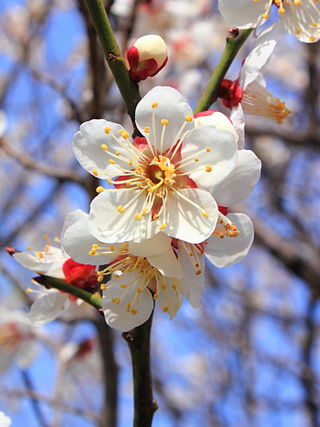
Prunus mume is a Chinese tree species classified in the Armeniaca section of the genus Prunus subgenus Prunus. Its common names include Chinese plum,Japanese plum, and Japanese apricot. The flower, long a beloved subject in the traditional painting and poetry of Sinospheric countries, is usually called plum blossom. This distinct tree species is related to both the plum and apricot trees. Although generally referred to as a plum in English, it is more closely related to the apricot. In East Asian cuisine, the fruit of the tree is used in juices, as a flavouring for alcohol, as a pickle, and in sauces. It is also used in traditional medicine.

Rosa multiflora is a species of rose known commonly as multiflora rose, baby rose, Japanese rose, many-flowered rose, seven-sisters rose, Eijitsu rose and rambler rose. It is native to eastern Asia, in China, Japan, and Korea. It should not be confused with Rosa rugosa, which is also known as "Japanese rose", or with polyantha roses which are garden cultivars derived from hybrids of R. multiflora. It was introduced to North America, where it is regarded as an invasive species.
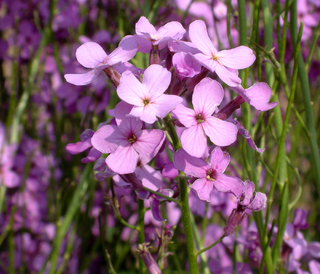
Hesperis matronalis is an herbaceous flowering plant species in the family Brassicaceae. It has numerous common names, including dame's rocket, damask-violet, dame's-violet, dames-wort, dame's gilliflower, night-scented gilliflower, queen's gilliflower, rogue's gilliflower, sweet rocket, and mother-of-the-evening.
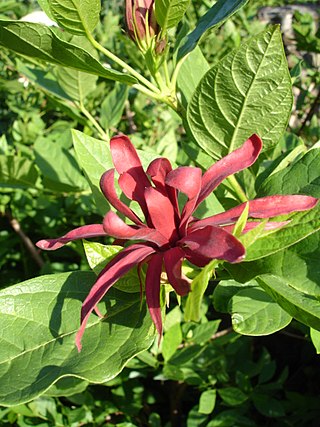
Calycanthus, called sweetshrub, is a genus of flowering plants in the family Calycanthaceae. The genus includes two to four species depending on taxonomic interpretation; three are accepted by most 21st century sources.

Heliotropium arborescens, the garden heliotrope or just heliotrope, is a species of flowering plant in the borage family Boraginaceae, native to Bolivia, Colombia, and Peru. Common names also include cherry pie and common heliotrope. It is an economically damaging invasive species in Australia.

Jasminum nudiflorum, the winter jasmine, is a slender, deciduous shrub native to China. The flower's blossoming peaks right after winter, which is why it is also named Yingchun (迎春) in Chinese, which means "the flower that welcomes Spring". It is widely cultivated as an ornamental and is reportedly naturalized in France and in scattered locations in the United States.

Iris chrysographes, the black iris, is a plant species that belongs to the genus Iris. It is native to Southern China and Myanmar (Burma), growing in meadows, streamsides, hillsides and forest margins.

Chimonanthus praecox, also known as wintersweet and Japanese allspice, is a species of flowering plant in the genus Chimonanthus of the family Calycanthaceae, native to China. The plant is known as làméi in Chinese. The plant is also grown in Iran, where it is called gol-e yakh or "ice flower" in Persian.

Forsythia suspensa, commonly known as weeping forsythia or golden-bell, is a species of flowering plant in the family Oleaceae. It is native to China.

Chimonanthus nitens is a species of the genus Chimonanthus (wintersweets) and a member of the family Calycanthaceae.

Chimonanthus salicifolius is a species of the genus of wintersweetsChimonanthus and member of the family Calycanthaceae.
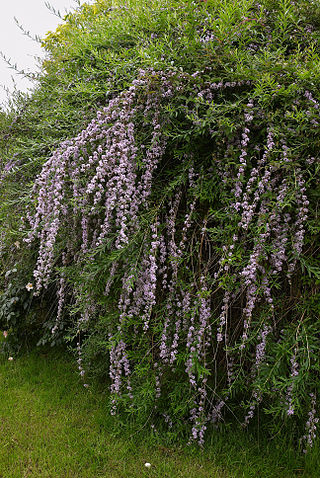
Buddleja alternifolia, known as alternate-leaved butterfly-bush, is a species of flowering plant in the figwort family, which is endemic to Gansu, China. A substantial deciduous shrub growing to 4 metres (13 ft) tall and wide, it bears grey-green leaves and graceful pendent racemes of scented lilac flowers in summer.

Garden roses are predominantly hybrid roses that are grown as ornamental plants in private or public gardens. They are one of the most popular and widely cultivated groups of flowering plants, especially in temperate climates. An enormous number of garden cultivars has been produced, especially over the last two centuries, though roses have been known in the garden for millennia beforehand. While most garden roses are grown for their flowers, often in dedicated rose gardens, some are also valued for other reasons, such as having ornamental fruit, providing ground cover, or for hedging.

Buddleja officinalis is a deciduous early-spring flowering shrub native to west Hubei, Sichuan, and Yunnan provinces in China. Discovered in 1875 by Pavel Piasetski, a surgeon in the Russian army, B. officinalis was named and described by Maximowicz in 1880. Introduced to western cultivation in 1908, B. officinalis was accorded the Royal Horticultural Society's Award of Merit three years later, and the Award of Garden Merit in 2002.
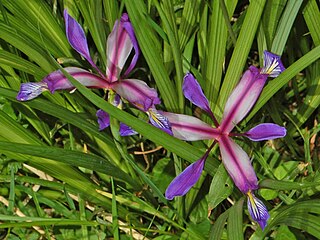
Iris graminea is a species of flowering plant belonging to the subgenus Limniris of the genus Iris, in particular the series Spuriae. It is a rhizomatous perennial, with purple or violet blue flowers almost hidden by narrow, grass-like leaves, and a plum scented fragrance. It is cultivated as an ornamental plant in temperate regions. It has several common names, including grass-leaved flag, grass leaved iris, plum iris and plum tart iris. This species naturally occurs in the southern half of Europe, from Spain and France in the West to Russia and the Caucasus in the East.

Roscoea humeana is a species of flowering plant in the family Zingiberaceae. It is a perennial occurring in the Sichuan and Yunnan provinces of China. Most members of the ginger family, to which it belongs, are tropical, but R. humeana, like other species of Roscoea, grows in much colder mountainous regions. It is also grown as an ornamental plant in gardens.

Roscoea praecox is a perennial herbaceous plant occurring in the Yunnan province of China. Most members of the ginger family (Zingiberaceae), to which it belongs, are tropical, but R. praecox, like other species of Roscoea, grows in much colder mountainous regions. It is sometimes grown as an ornamental plant in gardens.

Cotoneaster frigidus, the tree cotoneaster, is a species of flowering plant in the genus Cotoneaster of the family Rosaceae, native to the Himalayas. It is a deciduous tree or shrub growing to 10–17 metres (33–56 ft), with smooth, matt, alternate leaves 6–12 cm long and 4–5 cm broad. The creamy-white flowers are followed by masses of small, globose, red fruit (pomes) 5 mm diameter in autumn, persisting into winter or later if not eaten by birds.

Forsythia europaea, commonly known as Albanian forsythia or European forsythia, is a species of flowering plant in the olive family, with a native range from Montenegro to northern Albania. It is the only species of Forsythia native to Europe; prior to its discovery in Albania in 1897, it was thought that all Forsythia were native to East Asia.




















